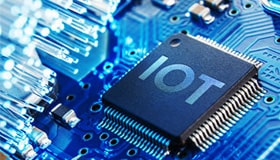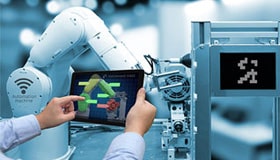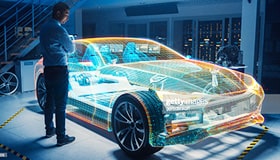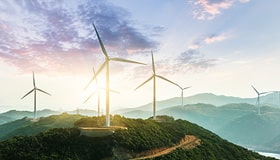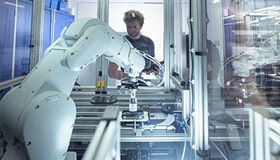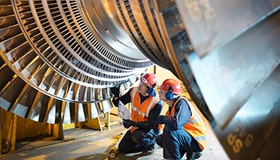IoT based energy efficiency solution in achieving Net-Zero
The trend toward "net zero" means that any emissions are balanced by absorbing an equal quantity from the environment to achieve the 1.5°C global warming target. IoT is essential to achieve net-zero because it includes technologies that leverage real-time data to optimize processes and decision-making. These solutions offer insight into energy consumption, potential wastage and empower the organization to maximize its efficiency and profitability whilst reducing its environmental impact.
Section 1 of the whitepaper "Smart Solutions for Energy Efficiency" discusses why it is important to achieve the net-zero (click here for more details). This blog discusses achieving net-zero through IoT-based energy-efficient solutions.
IoT based Solutions to achieving Net Zero:
IoT-enabled technology solutions are revolutionizing the way some organizations operate. A few of the said applications including Asset Management, Building Automation, Smart Transportation, and Smart Grid achieve operational efficiency and reduce energy consumption, resulting in a reduction in overall carbon emissions.
Factory Automation / Asset Management:
Reliability, efficiency, maintenance, and environmental impact are the main issues concerning power stations. Aged equipment is often the root of the problem with obsolete assets difficult to integrate with new technologies and systems. Adopting IoT-based automated processes and data analysis contributes to minimizing such challenges. Installing IoT sensors helps to communicate and store data in the cloud for an in-depth analysis to develop models to predict any malfunction before it occurs. These connected devices facilitate preemptive rather than reactive maintenance, increasing the reliability of this cumbersome equipment and making an efficient facility.
Building Automation:
Heating, ventilation, and air conditioning (HVAC) systems are the biggest energy consumers in a building's infrastructure. Smart building management systems such as IoT sensors and actuators are digitally connected with a centralized gateway to control HVAC to achieve better occupant experiences and effective resource management for reduced maintenance costs. Building management technology enables automatic monitoring, managing, and proactively controlling systems to maintain key parameters such as air quality and temperature control, with remote access to buildings.
IoT can also be applied to manage lighting systems in the infrastructure of a building. With smart lighting systems, Wi-Fi-enabled LED lights, which offer significant energy savings when turned on and off, can be controlled based on schedules, motion, or sound to turn on and off as needed and minimize excessive lighting energy usage. This contributes significantly to optimizing energy use and reducing related emissions, resulting in a net-zero building.
Smart Transportation / Fleet Management:
The major cause of air pollution is the rapid adoption of private vehicles over public transportation. Adopting IoT technologies provides a global management system, route optimization, vehicle maintenance, and tracking Utilizing a range of IoT-enabled devices such as RFID and GPS, which provide maximum efficiency with the least amount of time and power.
All components of the transportation system, including private and commercial vehicles, can be connected and their data processed. This facilitates congestion control and Smart parking systems, allowing passengers and drivers to choose a more cost-effective and time-efficient mode of transportation. IoT-based data management systems incentivize local inhabitants to utilize more environmentally friendly transportation alternatives whilst also allowing them to manage their schedules more effectively. This has the potential to significantly reduce transportation-related CO2 emissions and other air pollutants.
Smart Grid:
IoT and AI solutions have enhanced the effectiveness of renewable energy distribution models. Smart grid technologies combined with constant monitoring of real-time data inputs can disrupt the production of electricity and distribution with an accurate estimation of power usage to predict supply and demand. The reduction of transmission losses in T&D networks via active voltage management is another example where IoT can help make the grid more efficient. IoT technology with machine learning capability and AI-backed analytics can make renewable energy solutions such as solar panels and wind turbines more efficient and cost-effective.
Smart City:
The growing rate of urbanization is accompanied by various environmental concerns, including water and air pollution, in addition to energy access. One of the most significant issues is to supply cities with clean, affordable, and reliable energy. IoT technologies enable factories, residences, and offices to connect to the network and exchange real-time energy usage data. This enables Smart energy distribution across urban areas.
IoT can monitor individual buildings and objects, infrastructure, transport, and utilities. They could be connected to sensors to ensure energy efficiency via constant monitoring of data. For example, by using IoT to monitor traffic, traffic lights can be controlled to save electricity. This data can also be utilized to devise public transportation or traffic management strategies.
Newark has partnered with many different suppliers catering to a wide range of IoT products, and solutions portfolios, such as Industrial Wireless, Network gateways and kits, Smart Sensor, Signal Conditioning, Embedded Development Kits & Accessories, Process Controllers, Programmers & Indicators, Temperature Controllers, RFID modules, Network control-wireless, Process control-Wireless, RF / Wireless Development Kits, Machine Safety.
Stay informed
Keep up to date on the latest information and exclusive offers!
Subscribe now
Thanks for subscribing
Well done! You are now part of an elite group who receive the latest info on products, technologies and applications straight to your inbox.
